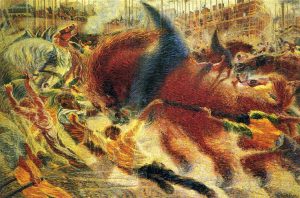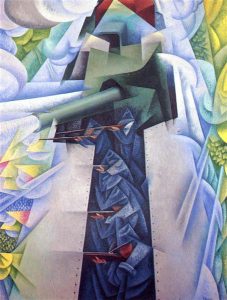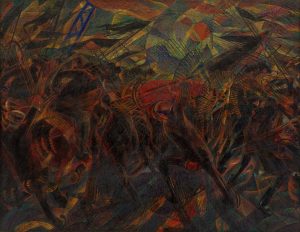Futurism: The Art Movement That Raced Ahead of Its Time
When the 20th century dawned, the world was changing at a breakneck speed.
Trains were faster, cities buzzed with new energy, and machines rumbled with a power never felt before.
For many, this rapid change was overwhelming.
But for a passionate group of Italian artists, it was exhilarating — even beautiful.
They didn’t want to escape the chaos of modern life. They wanted to celebrate it.
That celebration, that unrelenting passion for speed, technology, and dynamism, gave birth to Futurism — one of the most radical art movements of the 20th century.
The Birth of Futurism: A Manifesto of Rebellion
Futurism didn’t begin with a painting or a sculpture — it began with a manifesto.
On February 20, 1909, Italian poet Filippo Tommaso Marinetti published The Futurist Manifesto on the front page of the French newspaper Le Figaro.
His words were bold and brash, declaring war on the past and tradition. “We want no part of it,” he wrote. “The past is a cemetery!”
Marinetti and his fellow futurists were tired of Italy being seen as a museum of Roman ruins and Renaissance paintings.
They dreamed of a new Italy — modern, industrial, and alive with energy.
In their world, beauty was not found in quiet countryside scenes or religious icons, but in the roar of engines, the hum of factories, and the speed of a racing car.
“A racing car,” Marinetti declared, “is more beautiful than the Victory of Samothrace.”
The Core Ideas: Speed, Technology, Power
Futurism embraced everything new and exciting — speed, noise, violence, industry, youth, and even war.
To modern audiences, this might sound extreme, even dangerous. And in truth, Futurism often flirted with danger.
Its celebration of aggression and technology eventually aligned uncomfortably with political movements like Fascism.
But at its heart, Futurism was a cry for change — a refusal to be shackled by history.
The Futurists believed that art should reflect modern life. Just as life was constantly moving, art too should have movement, energy, and power.
This idea influenced not just painting, but also literature, sculpture, architecture, fashion, film, and even cuisine.
Key Artists and Their Work
Although Marinetti was the movement’s loudest voice, the visual side of Futurism was shaped by a group of pioneering painters and sculptors.
Each one brought a unique touch to the movement, but all shared a commitment to expressing dynamism and modernity.
Umberto Boccioni
Perhaps the most famous Futurist artist, Boccioni captured the power and rhythm of movement in both paint and bronze.
His painting “The City Rises” (1910) teems with energy, showing workers, buildings, and animals all merging into one pulsing force of urban growth.

But it is his sculpture “Unique Forms of Continuity in Space” (1913) that became an icon of Futurism.
The figure strides forward like a human machine, its body flowing with aerodynamic curves, as if it’s slicing through space and time.
Giacomo Balla
Balla explored motion with scientific precision.
His work “Dynamism of a Dog on a Leash” (1912) playfully yet brilliantly shows multiple legs, tails, and feet in motion, a kind of visual echo that mimics the blur of movement we see when something moves quickly.

Balla didn’t just want to paint what something looked like — he wanted to paint what it felt like to see it move.
Gino Severini
Severini, who lived in Paris and was influenced by Cubism, brought a sense of sophistication and rhythm to Futurism.
His painting “Armored Train in Action” (1915) fuses the glory and horror of modern war — gleaming metallic shapes, soldiers, and guns blend into one unstoppable force.

His work shows how Futurism celebrated the machine but also hinted at its terrifying power.
Carlo Carrà
Carrà’s early work, such as “Funeral of the Anarchist Galli” (1911), captures a violent political protest with swirling shapes and chaotic lines.

It’s as much about emotion as it is about motion — a powerful remind that Futurism was not just fascinated by machines, but also by the emotional energy of modern life.
Beyond the Canvas: Futurism in Everyday Life
Futurism was more than just an art style — it was a lifestyle.
The Futurists wanted to revolutionize everything from poetry to clothing to food.
They created “Futurist Cuisine,” serving meals like “aerofood” (small bites meant to be eaten blindfolded while listening to music and feeling different textures).
It might sound bizarre today, but to the Futurists, it was all part of waking people up from routine and tradition.
They also experimented with typography and visual poetry, throwing away grammar, punctuation, and structure in favor of chaotic, energetic page designs that looked as wild as they sounded.
Words exploded across the page, mimicking the sounds and sensations of modern life.
Influence and Legacy
Futurism was short-lived in its purest form. By the 1920s, the movement had splintered, and many of its founders either died young or drifted into politics.
Marinetti became an enthusiastic supporter of Mussolini’s Fascist regime, and Futurism’s close ties to nationalism and militarism led many to distance themselves from it after World War II.
Yet the spirit of Futurism lived on.
You can see its echoes in Modernist architecture, graphic design, and industrial aesthetics.
Movements like Vorticism in Britain and Russian Constructivism were heavily inspired by Futurist ideas. Even today, in a world driven by speed, innovation, and digital motion, Futurism feels oddly contemporary.
In many ways, we are living in the world the Futurists dreamed of — a world where machines talk, cars drive themselves, and cities stretch toward the clouds.
Designers, filmmakers, and digital artists continue to channel that love for speed and dynamism.
Video game aesthetics, kinetic typography, and even action movie montages all owe a little something to the Futurists’ belief that art should capture motion, energy, and the thrill of the modern.
A Human Perspective: What Can We Learn?
Futurism wasn’t perfect.
It was loud, chaotic, sometimes violent.
But it was also deeply human. At its core was a yearning — a desire to break free from the past and to embrace the future with open arms.
The Futurists saw a world changing faster than ever and instead of fearing it, they tried to race alongside it.
They asked us: What does it mean to be modern? What does it feel like to live in a world where everything is in motion?
Their art reminds us that change can be exhilarating — and terrifying. That we can find beauty in unexpected places — even in machines and speed.
And that art is not just about looking back; sometimes, it’s about rushing forward, eyes wide open.
In the end, Futurism was not just a movement.
It was a moment — a breathless, powerful moment — when artists looked into the future and saw not fear, but possibility.


